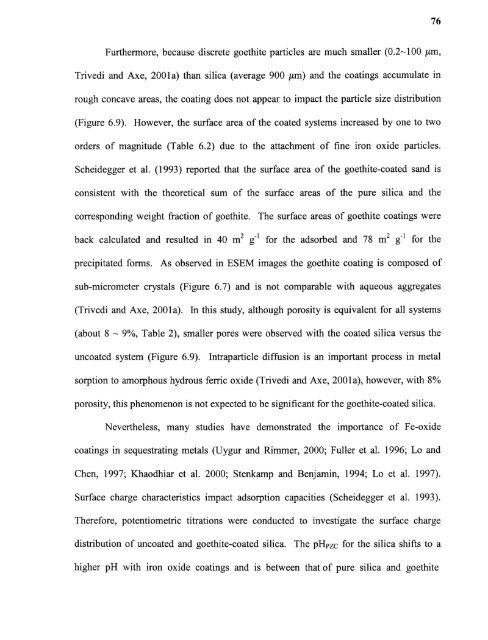Heavy metal adsorption on iron oxide and iron oxide-coated silica ...
Heavy metal adsorption on iron oxide and iron oxide-coated silica ...
Heavy metal adsorption on iron oxide and iron oxide-coated silica ...
You also want an ePaper? Increase the reach of your titles
YUMPU automatically turns print PDFs into web optimized ePapers that Google loves.
76Furthermore, because discrete goethite particles are much smaller (0.2100 pm,Trivedi <strong>and</strong> Axe, 2001a) than <strong>silica</strong> (average 900 pm) <strong>and</strong> the coatings accumulate inrough c<strong>on</strong>cave areas, the coating does not appear to impact the particle size distributi<strong>on</strong>(Figure 6.9). However, the surface area of the <strong>coated</strong> systems increased by <strong>on</strong>e to twoorders of magnitude (Table 6.2) due to the attachment of fine ir<strong>on</strong> <strong>oxide</strong> particles.Scheidegger et al. (1993) reported that the surface area of the goethite-<strong>coated</strong> s<strong>and</strong> isc<strong>on</strong>sistent with the theoretical sum of the surface areas of the pure <strong>silica</strong> <strong>and</strong> thecorresp<strong>on</strong>ding weight fracti<strong>on</strong> of goethite. The surface areas of goethite coatings wereback calculated <strong>and</strong> resulted in 40 m 2 g-1 for the adsorbed <strong>and</strong> 78 m 2 g-1 for theprecipitated forms. As observed in ESEM images the goethite coating is composed ofsub-micrometer crystals (Figure 6.7) <strong>and</strong> is not comparable with aqueous aggregates(Trivedi <strong>and</strong> Axe, 2001a). In this study, although porosity is equivalent for all systems(about 8 — 9%, Table 2), smaller pores were observed with the <strong>coated</strong> <strong>silica</strong> versus theun<strong>coated</strong> system (Figure 6.9). Intraparticle diffusi<strong>on</strong> is an important process in <str<strong>on</strong>g>metal</str<strong>on</strong>g>sorpti<strong>on</strong> to amorphous hydrous ferric <strong>oxide</strong> (Trivedi <strong>and</strong> Axe, 2001a), however, with 8%porosity, this phenomen<strong>on</strong> is not expected to be significant for the goethite-<strong>coated</strong> <strong>silica</strong>.Nevertheless, many studies have dem<strong>on</strong>strated the importance of Fe-<strong>oxide</strong>coatings in sequestrating <str<strong>on</strong>g>metal</str<strong>on</strong>g>s (Uygur <strong>and</strong> Rimmer, 2000; Fuller et al. 1996; Lo <strong>and</strong>Chen, 1997; Khaodhiar et al. 2000; Stenkamp <strong>and</strong> Benjamin, 1994; Lo et al. 1997).Surface charge characteristics impact <str<strong>on</strong>g>adsorpti<strong>on</strong></str<strong>on</strong>g> capacities (Scheidegger et al. 1993).Therefore, potentiometric titrati<strong>on</strong>s were c<strong>on</strong>ducted to investigate the surface chargedistributi<strong>on</strong> of un<strong>coated</strong> <strong>and</strong> goethite-<strong>coated</strong> <strong>silica</strong>. The pHpzc for the <strong>silica</strong> shifts to ahigher pH with ir<strong>on</strong> <strong>oxide</strong> coatings <strong>and</strong> is between that of pure <strong>silica</strong> <strong>and</strong> goethite
















